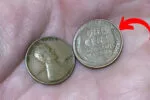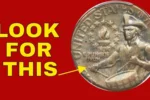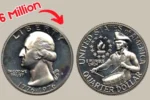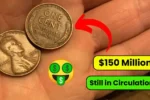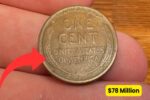6 Rare State Quarters value is $549 Million USD – Still in Circulating
Launched by the U.S. Mint in 1999, the 50 State Quarters Program remains one of America’s most beloved and successful coin releases.
Between 1999 and 2008, five unique quarter designs were released each year, each one celebrating a different state in the order they joined the Union. The goal was to educate the public and inspire a new generation of coin collectors.
Though the quarters were made for wide circulation—minted in the hundreds of millions—some of them are now considered rare and valuable due to minting errors, die damage, or limited production runs.
In this article, we’ll take a closer look at six standout state quarters that have gained serious interest among collectors. These aren’t just coins—they’re quirky pieces of history, artistic mistakes, and rare collectibles that might even be hiding in your spare change.
The 2004-D Wisconsin “Extra Leaf” Quarter
How It Was Found and Why It Matters
This variety sparked major buzz when people noticed something strange on the 2004 Wisconsin state quarter—an extra leaf on the corn. Released as the 30th design in the series, the coin normally shows a cow, a cheese wheel, and a corn stalk. But some versions had an additional leaf sticking out, either pointing up or down.
The Mint initially denied anything was intentional, which led to a wave of theories. Experts now believe it was caused by a damaged die—likely from a gouge that either happened accidentally or was caused intentionally by someone at the Mint.
Two Known Versions
The “High Leaf” variety has the extra leaf pointing upward.
The “Low Leaf” variety shows the leaf drooping downward toward the cheese.
These errors are subtle, and spotting the real deal means using a magnifying glass and comparing the coin’s metal flow to authenticated examples.
Market Value
Circulated examples: $50–$150
Uncirculated: $250–$500
Graded MS-65 or higher: $800–$1,200
Because these quarters were released to the public, it’s still possible to find one in everyday change—adding a sense of treasure hunt to the hobby.
The 2005-P Minnesota “Extra Tree” Quarter
What Makes It Special
After the Wisconsin discovery, collectors examined newer state quarters with a closer eye. In 2005, the Minnesota design—featuring pine trees, lakes, and the state outline—revealed a new error: what looked like an extra tree near the normal tree on the design.
Again, the cause was die damage, not an intentional change.
How Rare Is It?
This variety is rarer than the Wisconsin quarter. Most finds came from the Midwest, and many were discovered in mint sets or shortly after the coin was released.
Authentication can be tricky and usually requires comparing it to confirmed versions.
Value Breakdown
Circulated coins: $75–$200
Uncirculated: $300–$600
High-grade certified: $1,000–$1,500
Due to its rarity and limited attention when it was released, this quarter has become a top collectible.
The 2000-P New Hampshire “Wounded Eagle” Quarter
The Unusual Error
This design, the ninth in the series, featured New Hampshire’s Old Man of the Mountain and an eagle. Some coins appeared to show a deep scratch across the eagle’s chest—dubbed the “Wounded Eagle.”
The mark wasn’t just a scratch—it was a raised line caused by a die gouge during minting.
What to Look For
Real versions all show the line in the exact same place, with smooth, rounded edges. Counterfeits often have rough or uneven scratches.
Price Guide
Circulated examples: $75–$150
Uncirculated: $200–$400
Graded high: $600–$900
This variety is especially collectible due to the emotional connection to the now-collapsed Old Man of the Mountain.
The 1999-P Delaware “Spitting Horse” Quarter
The First Big Error of the Series
The very first quarter in the program featured Caesar Rodney on horseback. Soon after its release, collectors found a version where it looked like the horse was spitting.
The “spit” was caused by a die crack extending from the horse’s mouth.
Why It’s Scarce
As the first coin released, mint quality control was likely more rigorous. Plus, the die crack likely got worse over time, so only later-stage coins show the full effect.
Current Value
Circulated coins: $20–$50
Uncirculated: $40–$100
Graded MS-65 or above: $150–$300
It might not fetch as much as others, but it has strong collector nostalgia.
The 2004-P North Dakota “Extra Hand” Quarter
A Subtle But Strange Error
This coin featured bison and celebrated the Peace Medal given during the Lewis and Clark expedition. But some collectors found what looked like an extra finger or hand near the medal.
As with others, this was caused by die damage and appears as a smooth, raised shape not found in the original artwork.
Things to Note
Only authenticated examples show consistent metal flow and the feature in the same spot. Variations are typically post-mint damage.
Market Trends
Circulated: $30–$75
Uncirculated: $75–$150
Graded top-tier: $200–$400
This one flies under the radar, but serious collectors value its uniqueness.
The 2000 Massachusetts “Mule” Quarter
An Extremely Rare Blunder
Unlike the others, this isn’t just a design glitch—it’s a full-blown minting mistake. A small batch of Massachusetts quarters were struck with the reverse of the state quarter but the front of a Sacagawea dollar!
This is known as a “mule”—when two mismatched dies are used to make a coin.
How Rare?
Fewer than 20 have been confirmed. All are uncirculated, meaning they were likely caught early. The coin has a silver back and golden front—a shocking contrast that makes it visually stunning.
Auction Prices
Authenticated coins have sold for $10,000–$35,000
The best-condition examples have seen rising prices in recent years
This is one of the most prized state quarter errors ever found.
Total Value of These Six Rare Quarters: $549 Million?
These six unusual quarters capture everything that makes coin collecting so fascinating—history, rarity, error, and the excitement of finding something valuable in the most unexpected places.
From the relatively affordable Delaware Spitting Horse to the ultra-rare Massachusetts mule, there’s a wide range of price points for collectors.
Best of all? With the exception of the mule, these coins were all released into public circulation. That means the next time you get change back, you might want to give your quarters a second look—you never know what treasure you might find.
Whether you’re in it for the history or the hunt, these quarters prove that modern coins still hold surprises.
Latest Updates
